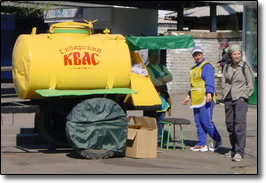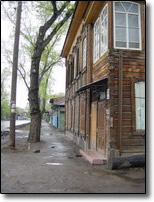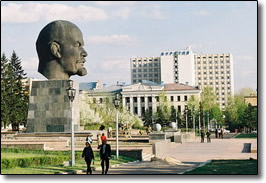
Ulan Ude
Back in Irkutsk, we took advantage of the giant market to fill up on fresh food, baked goods and draft beer. Outside, babushkas were selling farm-fresh produce, pickles and mushrooms. There was time to wander around the streets of Irkutsk, admiring the wooden houses. The first-floor windows of some lay below street level, where they had been partially buried by the rising streets. There are even a few wooden palaces in town, build by the wealthy exiles of the December Uprising of 1825.
 |
 |
We moved on to Ulan Ude, about eight hours away. The train swept down to Kultuk, then followed the lake before turning up a long, green valley. Baikal's eastern shore was packed thick with icebergs. In Ulan Ude, the proud home of the world's largest Lenin head (carved from a single block of stone), we were surrounded by a majority of asian-looking people who spoke Russian.
We checked into a genuine, high-rise, Soviet-era hotel, the “Buryatya”, complete with rusty pipes and creaking elevators. On the top floor, with a view of the main square and Lenin's head, we tried not to think about the fact that the area was prone to earthquakes. Would such a Soviet-era building survive? Overall, Ulan Ude was laid-back and the people were friendly. Outside of town is a Buddhist monastery, its Mongolian-style temples a riot of crazy colors and peaked roofs.

